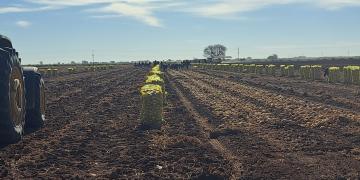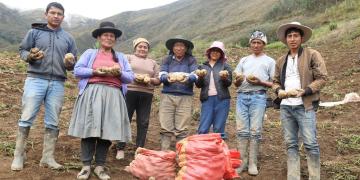Gran Bretaña: Shallower potato cultivation depths recommended in wet season
Potato growers are advised to reduce cultivation depths this season to improve soil condition and work rates, as persistent rain stops play.

With the optimum planting window narrowing, independent potato consultant Mark Stalham advises growers to reduce cultivations by 5-6cm, since producing 28cm-deep beds will save both time and diesel.
See also: Scottish oat growers set to benefit from streamlined Leaf audits
“Typically speaking, potato growers work soils too deep, producing destoned beds 33-34cm deep. This risks destructuring soils and the extra porosity created can cause slumping – particularly in the current wet conditions,” explains Dr Stalham.
“Growers are working machines unnecessarily harder, wasting time and energy for no real benefit.”
Advertisement
Save time and fuel
Instead, he recommends working shallower by 5-6cm on average, which allows machines to move 20-40% faster.
This means growers can cut costly fuel costs and cover a greater land area in a given time period to get potatoes planted in a more optimum time window.
“By moving, on average, 30% faster, this can gain an extra two days of planting a week. Multiply this up across a significant area, and this could gain farmers about two weeks.”
He says that on heavier ground, cultivation should be reduced to as shallow as 24-25cm. This is because clay soils dry slower at depth and have a shallower critical cultivation depth.
This has greater potential to improve work rates and fuel usage. It’s important to note that producing beds this shallow will not affect planting depth or time from planting to emergence.
Lagging behind schedule
On average, two-thirds of the UK potato crop is planted in the middle two weeks of April, so growers would normally be about 50% planted.
However, concerns grow as continued rain showers diminish chances of planting within this optimum window, with just 20% of the area estimated to be currently in the ground.
Explore moreKnow How
Visit our Know How centre for practical farming advice
Potatoes establishment
Potatoes land preparation
“Yield potential is lost when crops are planted after early May as it is more challenging to achieve full ground cover by the longest day,” he continues.
Shallower cultivation provides an opportunity for growers to catch up on lost time, reduce costly fuel bills and potentially increase yield.
Furthermore, it can help reduce risks of overloading destoners, which can create severe compaction pans, even on sandy soils.
Mark Stalham
Mark Stalham © Mark Stalham Potato Consultancy
Overly deep cultivations can also lead to soil structure damage and smearing on heavier soils with a clay content greater than 12-14%, which restricts root growth and compromises yield.
As a rule of thumb, destoning deeper than 35cm on sandy soils and deeper than 28cm on heavy soils will reduce yields.
He notes that soil types with more than 30% stone content may require deeper cultivation and destoning. Achieve a bed depth of 33-35cm to avoid bruising and mechanical damage in this scenario.
Next steps
Growers will be looking to get planting in the last two weeks of April to avoid yield implications associated with delayed planting, notes Dr Stalham.
However, unsettled weather forecast for the next few weeks make this seem unlikely as the plastic limit of soils are at field capacity, which makes cultivation difficult without incurring damage.
With three times greater rainfall in March compared to the long-term average, soils have lost structure and air capacity due to the greater water input, while frequent rain showers prevent soils from drying.
Optimum seed-beds remain top priorities for growers since they have a major influence on yield.
Ironically, soil conditions were fantastic in February and early March, but this was too early for planting as soils were too cold.
“What we need now is three to four days of sunny, dry and windy weather to dry out the soil surface and then growers can progress, heeding the comments on shallower cultivation”, concludes Dr Stalham.
Fuente: https://www.fwi.co.uk/arable/potatoes/shallower-potato-cultivation-depths-recommended-in-wet-season




